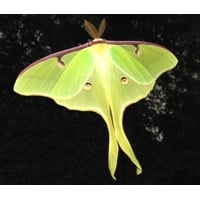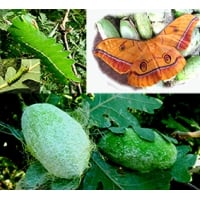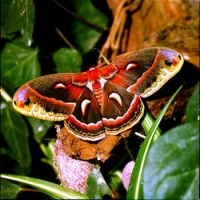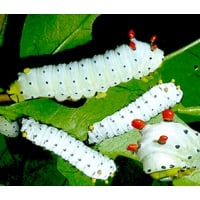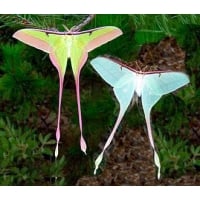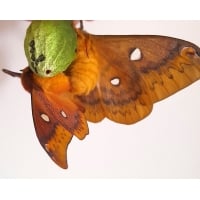SPRING and SUMMER EGGS and LARVAE Order now for supply in season
Spanish Moon Moth Graellsia isabellae
One of the rarest and most coveted species we list. The moth and larva are as exotic as any tropical species.
Foodplant Pine. The larvae change dramatically as they grow, starting with a precise imitation of pine twigs, amongst which they rest by day, then changing to patterns of green, black and white as they venture amongst the foliage. Finally they take on an intricate pattern, adding red to a criptic camouflage that renders them almost impossible to spot against the light in the pine forest. The larvae make a cocoon amongst mosses and leaf litter on the ground.
This is a delicate species that often does best sleeved out of doors, as long as the weather is good. They are used to a warm Spanish climate. Orders are supplied in strict rotation. It pays to order early to be high up the list.
American Moon Moth Actias luna North America
A very attractive Moon Moth that is double brooded and is very easy to rear. Larvae of the first brood produce moths this year.
The larvae feed on Walnut, and have been recorded as accepting Liquidambar, Birch, Plane, Maples, Aspen, Plum, Sallow, Osier Willow and several kinds of Oak. We have excellent results with Walnut and Osier.
Store autumn cocoons cool, even in a fridge from December onwards. In April they can be incubated for emergence in May.
Giant Atlas Moth Attacus atlas
One of the largest of all moth species in the world! The larvae feed well on Privet, at any time of the year, and might accept Portuguese Laurel. They require very clean conditions, always with fresh food. Alternative recorded foodplants include Willows, Lilac, Apple, Plum, Ash, Cherry and Tree of Heaven Ailanthus. Atlas larvae like to browse on several foodplants and settle for the one or more that they like.
The larvae like warmth 25 -30 degrees C and humid jungle conditions, which are best achieved in a tank or plastic container, rather than a netting cage. Given these conditions the larvae are not difficult to rear, and spin cocoons in about 8 weeks from hatching.
Antheraea yamamai Japan and Central Europe
A rewarding and easy species to rear in spring. The eggs are stored cool for the winter. Bring them into room temperature when the buds open, and the larvae hatch in a couple of weeks or so.
The caterpillar, a close relative of Antheraea pernyi, the Chinese Oak Silkmoth, grows very large. It has a green face and more interestingly, it spins a wonderful egg-shaped cocoon of BRIGHT GREEN silk. Very easy to rear on Oak. The larvae sometime take leaves of other trees and shrubs. Hawthorn is a early substitute for Oak. The pupa is spun in summer and does not emerge until well into autumn. Eggs laid in summer, are dormant through winter; they can be refrigerated, and hatch when the buds open in spring.
The female moth may be a bright canary yellow, with large ringed eye-spots, one in the centre of each wing. Colouring, especially in the male, is rather varied. Both sexes are illustrated with quite different colour forms.
Chinese Silkmoth Antheraea pernyi
Highly recommended for those who are looking for a spectacular moth, with LARGE exotic larvae: easily reared.
This species used to be universally available. Over the years captive bred stocks have disappointingly become in-bred. We now have strong wild Chinese stock.
A large species, and undoubtedly the best for beginners. Moths emerge in the spring. They pair very easily.
Very easy to keep. Young larvae are black, and later turn green. They become enormous, feeding on Oak, Birch, Sweet Chestnut, Horse Chestnut, Prunus, Hornbeam (Carpinus), Apple, Hawthorn, Beech, Osier Willow. After about 2 months the larvae spin silk cocoons - an extra opportunity for a teaching project. Moths emerge the same year. Autumn larvae spin over-wintering cocoons.
Larvae thrive on Evergreen Oak when other plants not available. In winter, if the evergreen leaves are a bit leathery, make some incisions in the leaves with scissors. This releases attractive scent to the larvae and and gives them easier places to start feeding.
A PERFECT species for children and beginners!
Bullseye Moth Automeris io North America
Eggs and Larvae of the Bullseye Moth are not available every year. This small silkmoth has a number of interesting characteristics.
The male and female are distinctly different colours – both have the enormous eye markings on the hindwings which are exposed when the moth is disturbed.
The larvae are covered by branched spines – don’t touch them – they sting like a nettle! They are gregarious until the larvae are quite large, changing colour at each skin change.
For pairing, keep the moths in a cage the size of the Pyjama Mini Cage. Fertile eggs develop a black dot which is the micropyle, through which the embryo breathes. A useful indicator of fertility, not present in most other species.
The larvae are polyphagous, ie they will accept a wide variety of foodplants, which include such trees as Oak, Lime, Willow, Hazel, Bramble, Apple, Hawthorn and more.
Saturnia jonasii Far East Russia 10 eggs
Keep eggs refrigerated until late March, or when the first buds open.
The last time this species was offered by WWB was over 40 years ago! The young larvae are most decorative. Recorded foodplants include Ornamental Crab Apple Malus, Hawthorn, Sallow, Osier, Sometimes Privet and undoubtedly a number of other trees and shrubs.
Final instar larvae are covered in short bristles and the caterpillar is lime green all over.
The moths emerge in autumn. Their eggs hatch in the following spring.
Robin Moth Hyalophora cecropia North America
THIS SPECIAL OFFER is because our breeder has had exceptional success and wants to share his stock with more people. The offer may last only a few days so don't miss out!
This is a magnificent species with most decorative larvae that are easy to rear, especially when sleeved. The moth will sit on your finger fanning its wings, like a pet! Highly recommended.
Cecropia is famous and has now become very difficult to obtain. We are pleased to be able to offer eggs again this season. Please take advantage of this opportunity because they may not always be available.
A magnificent and very large moth, coloured with scarlet and charcoal. The larvae are most attractive and easily reared with careful hygiene. They do well sleeved outside in good weather. Osier Willow is the plant that succeeds best for us, and many breeders use Cherry.
Reported foodplants: Lilac, Cherry, Pear, Apple, Plum, Alder, Birch, Dogwood, Willows especially Osier Salix viminalis, Elm, Beech, Gooseberry, Poplar.
Cherry Moth Callosamia promethea North America
The male and female moths are so different that they might be taken for two different species. The male is mainly black, with very shapely wings. The ground colour of the female is wine red.
Promethea flies and breeds by day: the males like sunshine but must not be left out to bake. Pairing is often easy, and sometimes difficult!
The larvae are gregarious until quite large, when they take on a very unusual appearance, being white, with knobbles like sealing wax in bright reds, yellows and oranges.
Foodplants include Lilac and Cherry, Privet, Ash, Apple, Pear, Oak, Rhododendron, Willow, Lime, Tulip Tree Liriodendron, Peach, possibly Maple, Poplar and even Pine will also be taken.
Actias dubernardi China
This is a species that is very difficult to obtain.
The moths have exceptionally long tails for their size. Male and female are differently coloured (the male is the pink and yellow one).
The larvae feed exclusively on Pine, amongst which they are remarkably well camouflaged. Young larvae mimic the Pine male catkins. Larger larvae are easily lost among the Pine needles, yet they are contrastingly marked and patterned with bright spangles, and startling colours between the segments.
This is a must for the serious breeder!
Squeaking Silkmoth Rhodinia fugax Far East 15 eggs
We are sure that Rhodinia fugax will bring a lot of pleasure to breeders, and happy memories to those who have reared the Squeaking Silkmoth before.
Large larvae squeak when touched or disturbed by noise. Even the pupa squeaks within the extraordinary cocoon, which is green and shaped like a pitcher plant, with an open top. The vessel would fill with water when it rains, but the caterpillar spins a drainage hole in the bottom!
Foodplants include Oak, Sycamore, Maples, Willows and Sallows, Osier, Beech, Hawthorn, and doubtless many other trees and shrubs. Younger larvae change colour at each skin change. Final instar larvae have a clearly defined lateral demarkation between a dark green underside and bright lime green topside, which breaks the recogniseable shape of the caterpillar and helps it to avoid detection by predators.
Moths emerge in autumn. Males are beautifully patterned in chestnut brown. Females are much larger, and patterned in yellow. Eggs laid in autumn remain unhatched until buds open in the spring. Store in a fridge or very cold place, slightly humid, but beware of mould. Don't keep them chilled longer than necessary. You should incubate the eggs as early as food is available in spring. March and April are the best months to incubate.


